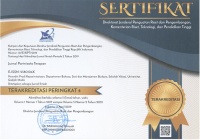Kemenarikan Objek Wisata Instagram Dalam Perencanaan Pariwisata
Ebtana Sella Mayang Fitri(1*), Ridho Gata Wijaya(2)
(1) Universitas Negeri Yogyakarta
(2) Universitas Negeri Yogyakarta
(*) Corresponding Author
Abstract
The development of Instagram tourism objects in various parts of the world has encouraged many tourists to compete with each other to visit the place. Based on previous studies, it was stated that most of the visitors from this Instagram tourist attraction were millennials. In terms of terminology, Instagram tourism attraction is a tourist destinations which have unique, exist, and hits characters. It also used and utilized as photo hunting objects to share on Instagram accounts. The high interest of millennial tourists to produce and get the good photos has encouraged the development of similar Instagram tourism attraction. According to Gunn (1993), tourist destinations can attract tourist visits if it have several components such as attractions, services, information, promotions and transportation. However, these components are not the main focus in planning and developing Instagram tourism. The purpose of this article is to try to analyze the attractiveness of Instagram tourism attraction and it can be used as a reference in planning the management of Instagram tourism objects. This article used a qualitative method by using secondary data sources which are collected from several scientific articles, books, statistical data, and newspaper media. The results of this article found that the attractiveness of Instagram tourism attraction is actually a tourist activity that solely wants to pursue visual pleasure because the character of this attraction type is a blurry attraction. Therefore, planning of the development of Instagram tourism attraction must consider the components that can encourage to creating/producing good visual quality.
Keywords
Full Text:
PDFReferences
Buhalis, D., Spada, A., (2000). Destination management systems: criteria for success–an exploratory research. Infrastructure Technology Tourism. Vol. 3, 41–58.
Cao, L. (2010). In-depth Behavior Understanding and Use: the Behavior Informatics Approach. Information Science 180(17), 3067-3085.
Cederholm, E. A. (2004). The use of photo elicitation in tourism research–framing the Backpacker Experience. Scandinavian Journal of Hospitality and Tourism, 4(3), 225‐241
Chalfen, R. (1979). Photography’s Role in Tourism: Some Unexplore Relationship, Annals of Toursm Research, 6(8), 435-447
Cooper, C., Fletcher, J., Fyall, A., Gilbert,D., dan Wanhill, S. (2008). Tourism: Principles & Practice, fourth edition. United Kingdom: Pearson Educational Limited.
Crompton, J. L. (1991). Motivations for Pleasure Vacations. Annals of Tourism Research. Vol. 6, No.4, Page. 408-424.
Fatanti dan Suyadnya. (2015). Beyond User Gaze: How Instagram Creates Tourism Destination Brand. Bali: Elsevier.
Fitri, ESM. (2019). Unus-unsur Kemenarikan Objek Wisata Instagram. Studi Kasus: Pesisir dan Perbukitan. Yogyakarta: Thesis Universitas Gadjah Mada
Garrod, B. (2008). Understanding the Relationship between Tourism Destination Imagery and Tourist Photography. SAGE Journal of Travel research. Volume: 47 issue: 3, page(s): 346-358.
Gunn. (1993). Tourism Planning: Basics, Concepts, Cases. Third Edition. London: Taylor and Francis,
Jenkins, O. H. (2003). Understanding and Measuring Tourist Destination Images. International Journal of Tourism Research, 1 (1): 1-15.
Listiono. (2017). Instagram, Wisata Foto dan Dampaknya terhadap Peningkatan Jumlah Wisatawan di Yogyakarta. UAD Yogyakarta: The 3th URECOL Proceeding.
Molinas, Maria Victoria Mora. (2019). Instagram and tourism development: a practical approach of the economic, social and environmental effects to Bali. Spanyol: Universitat de les Ille Balears.
Mulyana, D. (2006). Pengantar Ilmu Komunikasi. Bandung: PT. Remaja Rosdakarya.
Percy, L., dan Rossiter, J. R. (1983). Effects of picture size and colour on brand attitude responses in print advertising. Advances in consumer research, 10(1), 17‐20.
Radnawati, D dan Wariningsih, L. (2019). Peningkatan Kualitas Visual Lanskapjalan Di Sempadan Setu Babakan Pada Area Wisata Setu Babakan. NALARs Jurnal Arsitektur IPB. Volume 18. ISSN 1412-3266/e-ISSN 2549-6832.
Sarvas, R dan Frohlich, D. (2011). From Snapshots to Social Media - The Changing Picture of Domestic Photography. London: Springer.
Schofields. (2018). (https://www.forbes.com/sites/ andrewarnold/2018 /01/24/heres-how-much-instagram-likes-influence-millennials-choice-of -travel-destinations/).
Smith, S.P. (2018). Instagram Abroad: Performance, Consumption and Colonial Narrative in Tourism. Postcolonial Studies, 21(2), 172-191. doi: 10.1080/13688790.2018.1461173
Supangkat. (2005). Urban/ Culture. Jakarta: Kepustakaan Pupuler Gramedia.
Suwena dan Widyatmaja. (2017). Pengetahuan Ilmu Pariwisata. Denpasar: Pusaka Larasan.
Urry, J. (2002). The tourist Gaze. London: SAGE Publication.
Waidi. (2006). Pemahaman dan Teori Persepsi. Bandung: Remaja Karya.
Yoeti, Oka. (1997). Tours and Travel Management. Jakarta: PT. Pradnya Paramita.
Article Metrics
Refbacks
- There are currently no refbacks.
Copyright (c) 2024 Ebtana Sella Mayang Fitri, Ridho Gata Wijaya

This work is licensed under a Creative Commons Attribution-ShareAlike 4.0 International License.













